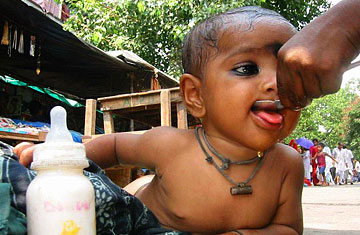
Of the 26 million children born in India each year, nearly 2 million die before age 5
Sharda, a 17-year-old mother, gave birth to her first child in February in a village in Noida, just a few hours' drive outside New Delhi. Though her son was born premature and weak, he received no treatment. In many parts of India, particularly in poor and marginalized communities, a woman is considered impure for a fortnight after giving birth. After labor, Sharda was relegated to a makeshift room outside her family's house made out of plastic sheets and tarpaulin. Heavy smoke from a wood fire warming the room filled the air, stinging Sharda's eyes as she lay in a corner. The baby was an invisible bundle beside her. Tiny and underweight, he died two months later.
Despite its drastic economic advances in the last two decades, India still accounts for 20% of the world's child mortality. Of the 26 million children born in India each year, nearly 2 million still die before age 5. Half of those deaths occur within a month of birth from preventable causes like malnutrition, diarrhea and pneumonia. Forty-eight percent of India's children under the age of 5 are chronically malnourished and 22% of India's babies are born with a low birth weight. India's rate of underweight children is three times higher than Ethiopia's.
This week in New York City, world leaders will gather to take stock of the Millennium Development Goals (MDGs), an ambitious set of eight goals adopted by countries around the world in 2000 to address pressing development challenges by 2015. India also committed to the MDGs, including MDG 4, which calls for each country to reduce its child mortality by two-thirds between 1990 (the baseline year for statistics for all MDGs) and 2015. While there has been progress — the rate dropped from 116 deaths per 1,000 children under age 5 in 1990 to 69 deaths per 1,000 children under 5 in 2008 — it is still a long way from the national target of 39 for every 1,000 births.
India, of course, is not the only nation grappling with this problem. In the run-up to this week's summit, UNICEF released a report highlighting the problem of child mortality throughout the developing world. The report says children from the poorest 20% of households in the developing world are more than twice as likely to die before reaching their fifth birthdays as children from the richest 20% of households. About half of under-5 deaths occur in six countries with large populations and high poverty rates: India, Nigeria, Democratic Republic of Congo, Ethiopia, Pakistan and China.
But India's progress has been particularly slow — and lopsided. Poor maternal education and archaic social customs, among other social and political factors, have been blamed for contributing to the enduring prevalence of child deaths. The majority come from poor households; in 2008, 530,000 children from families living under the poverty line died, compared with 178,000 from financially better-off ones. In prosperous and educated states like Kerala, the under-5 mortality rate is 14 deaths per every 1,000 child born. But it is 92 per 1,000 in Madhya Pradesh, 91 per 1,000 in Uttar Pradesh and 89 per 1,000 in Orissa — some of the poorest states in India.
A recent survey by the Global Movement for Children showed 80% of Indians were unaware of the large number of children dying every year in their own country, a lack of awareness that exacerbates the problem, says Thomas Chandy, the CEO of Save the Children India. Chandy says many traditional Indian customs discourage lifesaving practices like early breastfeeding and clean cutting of the umbilical cord. Labor, as seen in Sharda's case, is considered an unclean process and is therefore often carried out in an unclean place of the house, like a cow shed. The delivery space is frequently plastered with cow dung, which many Indians consider purifying but which in actuality increases the risk of infection for the child, according to the study. An overwhelming 92% of those surveyed felt that it was feasible for India to achieve MDG 4 on reducing under-5 mortality, Chandy told TIME.
As the most populous country in a region that accounts for a third of the world's child deaths, India's failure to reach its target could have a cascading effect on South Asia's development goals. Still, UNICEF's India representative Karin Hulshof says India seems to be committed to action. The federal government increased allocations for child-welfare schemes from $700 million in 2005-06 to $1.9 billion in 2010-11 and plans to increase health expenditure from 1.58% of GDP to 2% to 3%. "If you look at India's [own] 11th 5-year plan, it is more ambitious than the MDG," says Hulshof. "The challenge is to make it work." Making sure the increased funds — and India's increasing wealth — get to the nation's neediest will be key in more effectively tackling child mortality, says Chandy of Save the Children. "We do not need a major technological breakthrough," he says. "We know from India's better-performing states that improved child and maternal health and nutrition" comes from "successful economic development."
In Noida, Sharda was sent home to her parents for a month by her in-laws to help her get over the incident. When she returns, Sharda knows she will be expected to conceive again as soon as possible. The daily struggle against poverty in India doesn't allow families to grieve or dwell for long on the price of lost life, or its effect on a mother's physical and emotional well-being. In some areas, it is routine for women to lose a few babies before one lives. But true development in India will only come when such mind-sets are changed.
